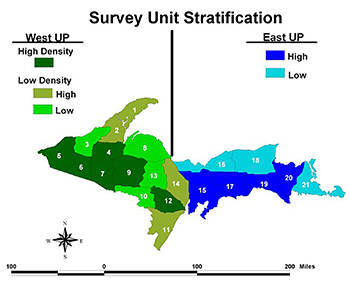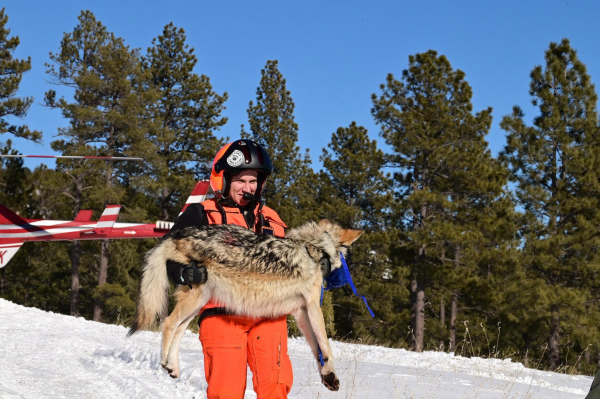Gray Wolves Removed from Endangered Species List
Deputy Secretary of the Interior Lynn Scarlett announced today the removal of the western Great Lakes population and portions of the northern Rocky Mountain population of gray wolves from protection under the Endangered Species Act.
The success of gray wolf recovery efforts in these areas has contributed to expanding populations of wolves that no longer require the protection of the Act. However, gray wolves found within the borders of Wyoming will continue to be protected by the Act due to a lack of adequate regulatory mechanisms ensuring their protection under state law.
“Wolves have recovered in the Great Lakes and the northern Rocky Mountains because of the hard work, cooperation and flexibility shown by States, tribes, conservation groups, federal agencies and citizens of both regions,” said Scarlett. “We can all be proud of our various roles in saving this icon of the American wilderness.”
Today’s decision by the U.S. Fish and Wildlife Service (Service) is scheduled to take effect 30 days after the publication of two separate rules, one for each population, in the Federal Register. The two rules address concerns raised during two separate federal court actions last summer requiring the Service to reinstate Endangered Species Act protections for the two populations. The western Great Lakes population was originally removed from the federal list of endangered and threatened wildlife and plants in March 2007, while the northern Rocky Mountain population was first delisted in February 2008.
Gray wolves were previously listed as endangered in the lower 48 states, except in Minnesota where they were listed as threatened. The Service oversees three separate recovery programs for the gray wolf; each has its own recovery plan and recovery goals based on the unique characteristics of wolf populations in each geographic area. Wolves in other parts of the 48 states, including the Southwest wolf population, remain endangered and are not affected by the actions taken today.
Northern Rocky Mountain wolves
The northern Rocky Mountain Distinct Population Segment includes all of Montana, Idaho and Wyoming, the eastern one-third of Washington and Oregon, and a small part of north-central Utah. The minimum recovery goal for wolves in the northern Rocky Mountains is at least 30 breeding pairs and at least 300 wolves for at least three consecutive years, a goal that was attained in 2002 and has been exceeded every year since. There are currently about 100 breeding pairs and 1,500 wolves in Montana, Idaho, and Wyoming. The Service believes that with approved state management plans in place in Montana and Idaho, all threats to the wolf population will be sufficiently reduced or eliminated in those states. Montana and Idaho will always manage for over 15 breeding pairs and 150 wolves per State and their target population level is about 400 wolves in Montana and 500 in Idaho.
As a result of a Montana United States District Court decision on July 18, 2008, the Service reexamined Wyoming law, its management plans and implementing regulations. While the Service has approved wolf management plans in Montana and Idaho, it has determined that Wyoming’s state law and wolf management plan are not sufficient to conserve Wyoming?s portion of a recovered northern Rocky Mountain wolf population. Therefore, even though Wyoming is included in the northern Rocky Mountain DPS, the subpopulation of gray wolves in Wyoming is not being removed from protection of the Endangered Species Act. Continued management under the Endangered Species Act by the Service will ensure that the recovery goal of 300 wolves in Wyoming is sustained.
Acting U.S. Fish and Wildlife Service Director Rowan Gould said the Service will continue to work with the State of Wyoming in developing its state regulatory framework so that the state can continue to maintain and share a recovered northern Rocky Mountain population. Once adequate regulatory mechanisms are in place, the Service could propose removing the Act’s protections for wolves in Wyoming. National parks and the Wind River Reservation in Wyoming already have adequate regulatory mechanisms in place to conserve wolves. However, at this time, wolves will remain protected as a nonessential, experimental population under the ESA throughout the state, including within the boundaries of the Wind River Reservation and national park units.
Western Great Lakes
The Service’s delisting of the gray wolf also applies to gray wolves in the Western Great Lakes Distinct Population Segment. As the result of another legal ruling from the Washington D.C. United States District Court on September 29, 2008, the Service reexamined its legal authorization to simultaneously identify and delist a population of wolves in the western Great Lakes. The Service today reissued the delisting decision in order to comply with the Court’s concerns.
The area included in the DPS boundary includes the states of Minnesota, Wisconsin and Michigan as well as parts of North Dakota, South Dakota, Iowa, Illinois, Indiana and Ohio. The DPS includes all the areas currently occupied by wolf packs in Minnesota, Michigan, and Wisconsin, as well as nearby areas in these states in which wolf packs may become established in the future. The DPS also includes surrounding areas into which wolves may disperse but are not likely to establish packs.
Rebounding from a few hundred wolves in Minnesota in the 1970s when listed as endangered, the region’s gray wolf population now numbers about 4,000 and occupies large portions of Wisconsin, Michigan and Minnesota. Wolf numbers in the three states have exceeded the numerical recovery criteria established in the species’ recovery plan for several years. In Minnesota, the population is estimated at 2,922. The estimated wolf population in Wisconsin is a minimum of 537, and about 520 wolves are believed to inhabit Michigan’s Upper Peninsula.
The Michigan, Minnesota, and Wisconsin Departments of Natural Resources have developed plans to guide wolf management actions in the future. The Service has determined that these plans establish a sufficient basis for long-term wolf management. They address issues such as protective regulations, control of problem animals, possible hunting and trapping seasons, and the long-term health of the wolf population, and will be governed by the appropriate state or tribe.
“The Service is committed to ensuring wolves thrive in the Great Lakes and the northern Rocky Mountains and will continue to work with the states to ensure this successful recovery is maintained,” said Gould.
The Service will monitor the delisted wolf populations for a minimum of five years to ensure that they continue to sustain their recovery. At the end of the monitoring period, the Service will decide if relisting, continued monitoring, or ending Service monitoring is appropriate.
The mission of the U.S. Fish and Wildlife Service is working with others to conserve, protect and enhance fish, wildlife, plants and their habitats for the continuing benefit of the American people. We are both a leader and trusted partner in fish and wildlife conservation, known for our scientific excellence, stewardship of lands and natural resources, dedicated professionals and commitment to public service. For more information on our work and the people who make it happen, visit www.fws.gov.






